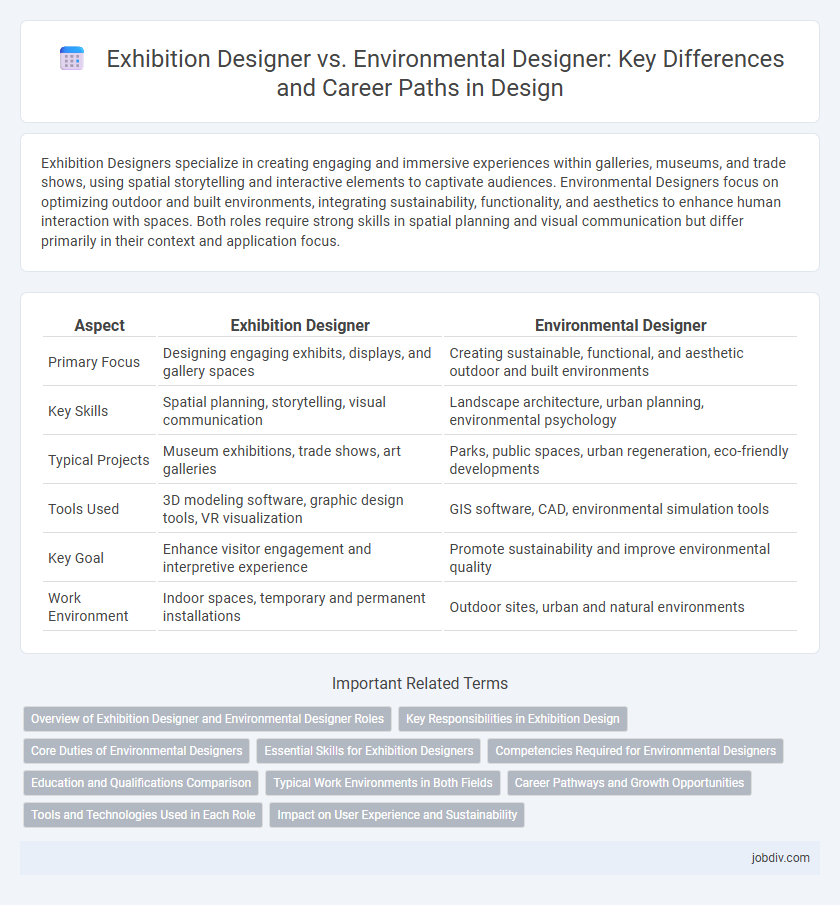Exhibition Designers specialize in creating engaging and immersive experiences within galleries, museums, and trade shows, using spatial storytelling and interactive elements to captivate audiences. Environmental Designers focus on optimizing outdoor and built environments, integrating sustainability, functionality, and aesthetics to enhance human interaction with spaces. Both roles require strong skills in spatial planning and visual communication but differ primarily in their context and application focus.
Table of Comparison
| Aspect | Exhibition Designer | Environmental Designer |
|---|---|---|
| Primary Focus | Designing engaging exhibits, displays, and gallery spaces | Creating sustainable, functional, and aesthetic outdoor and built environments |
| Key Skills | Spatial planning, storytelling, visual communication | Landscape architecture, urban planning, environmental psychology |
| Typical Projects | Museum exhibitions, trade shows, art galleries | Parks, public spaces, urban regeneration, eco-friendly developments |
| Tools Used | 3D modeling software, graphic design tools, VR visualization | GIS software, CAD, environmental simulation tools |
| Key Goal | Enhance visitor engagement and interpretive experience | Promote sustainability and improve environmental quality |
| Work Environment | Indoor spaces, temporary and permanent installations | Outdoor sites, urban and natural environments |
Overview of Exhibition Designer and Environmental Designer Roles
Exhibition designers create engaging displays and layouts for museums, galleries, trade shows, and events, emphasizing visitor experience and storytelling through spatial arrangement and interactive elements. Environmental designers focus on designing spaces that promote sustainability, functionality, and harmony between human activities and the natural environment, often incorporating urban planning, landscape architecture, and interior design principles. Both roles require a deep understanding of spatial design but differ in their primary goals: exhibition designers prioritize temporary, immersive experiences, while environmental designers emphasize long-term ecological and social impact.
Key Responsibilities in Exhibition Design
Exhibition designers specialize in creating engaging, visually compelling displays that effectively communicate a specific theme or message within galleries, museums, or trade shows. They focus on spatial planning, storytelling through visual elements, and incorporating interactive technology to enhance visitor experience. Unlike environmental designers who address broader environmental contexts including urban and landscape design, exhibition designers center their expertise on curating immersive, user-focused environments within confined interior spaces.
Core Duties of Environmental Designers
Environmental designers specialize in creating sustainable, functional spaces that integrate natural and built environments while addressing ecological and social impacts. Their core duties include site analysis, spatial planning, and the use of sustainable materials and technologies to enhance environmental quality and user experience. They collaborate with architects, urban planners, and engineers to develop designs that promote ecological balance and community well-being.
Essential Skills for Exhibition Designers
Exhibition designers require a strong proficiency in spatial planning, visual communication, and interactive media to create engaging, immersive visitor experiences. Expertise in materials, lighting design, and multimedia integration is essential for crafting dynamic displays that effectively convey narratives and brand messages. Collaboration skills and project management capabilities enable exhibition designers to coordinate with architects, curators, and fabricators, ensuring cohesive and functional exhibit environments.
Competencies Required for Environmental Designers
Environmental designers require expertise in sustainable design principles, spatial planning, and ecological impact assessment to create functional and environmentally responsible spaces. Proficiency in CAD software, knowledge of local regulations, and strong collaboration skills are essential for integrating environmental considerations into design projects. Understanding materials' environmental footprint and implementing energy-efficient solutions enhance their ability to develop innovative, eco-friendly environments.
Education and Qualifications Comparison
Exhibition designers typically require a bachelor's degree in exhibition design, graphic design, or a related field, emphasizing skills in spatial planning, visual communication, and multimedia integration. Environmental designers often pursue degrees in environmental design, architecture, or urban planning, focusing on sustainable design principles, human-environment interaction, and large-scale spatial development. Professional certification, such as NCIDQ for exhibition designers or LEED accreditation for environmental designers, can enhance credibility and career advancement.
Typical Work Environments in Both Fields
Exhibition designers typically work in museums, galleries, and trade show venues, creating compelling displays that enhance visitor engagement and storytelling. Environmental designers operate in a broader range of settings, including urban planning offices, landscape architecture firms, and public spaces, focusing on sustainable and functional outdoor and indoor environments. Both fields require collaboration with clients, architects, and contractors to translate design concepts into practical, aesthetically pleasing environments.
Career Pathways and Growth Opportunities
Exhibition Designers specialize in creating engaging displays for museums, trade shows, and galleries, with career growth often involving roles such as Lead Designer or Creative Director in cultural and commercial settings. Environmental Designers focus on sustainable and functional spaces, merging architecture, landscape, and interior design, often advancing to urban planning or sustainable design consultancy positions. Both fields require strong skills in spatial design and technology, but Exhibition Designers may have more project-based opportunities, while Environmental Designers benefit from broader impact roles in public and private sector developments.
Tools and Technologies Used in Each Role
Exhibition designers utilize tools such as 3D modeling software like SketchUp and AutoCAD to create immersive displays and spatial layouts, often integrating multimedia elements using Adobe Creative Suite and video projection technology. Environmental designers employ GIS mapping, BIM (Building Information Modeling) software like Revit, and sustainable material databases to develop eco-friendly spaces that address ecological impact and urban planning needs. Both roles leverage virtual reality (VR) and augmented reality (AR) platforms to visualize and refine designs, but their emphasis on software and technologies aligns with their distinct project goals.
Impact on User Experience and Sustainability
Exhibition designers craft immersive spaces that engage visitors through visual storytelling and interactive elements, enhancing user experience by creating memorable, educational encounters. Environmental designers prioritize sustainable solutions in built environments, integrating eco-friendly materials and energy-efficient systems to minimize ecological impact while promoting user well-being. Both roles influence user experience and sustainability, with exhibition designers focusing on narrative impact and environmental designers emphasizing long-term ecological responsibility.
Exhibition Designer vs Environmental Designer Infographic

 jobdiv.com
jobdiv.com